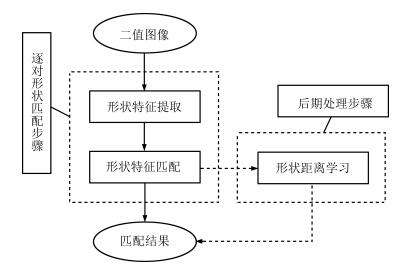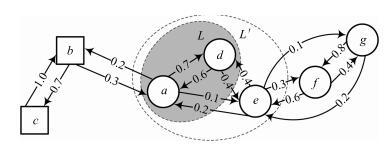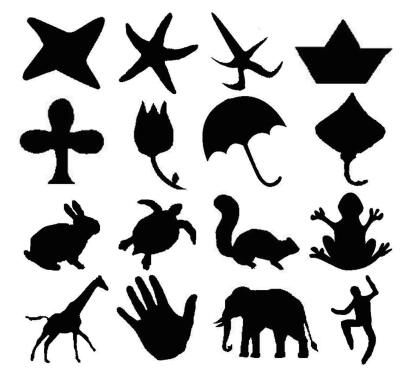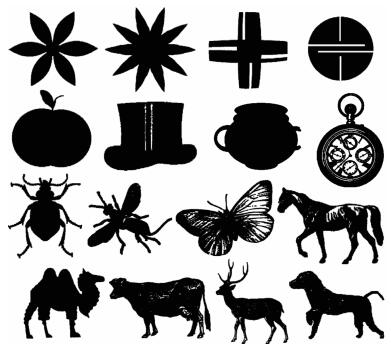-
摘要: 形状距离学习是形状匹配框架中引入的后处理步骤, 能够有效改善逐对计算得到的形状间距离.利用期望首达时间分析形状间相似度可能导致距离更新不准确, 针对这一问题提出了一种基于广义期望首达时间 (Generalized mean first-passage time, GMFPT) 的形状距离学习方法.将形状样本集合视作状态空间, 广义期望首达时间表示质点由一个状态转移至指定状态集合所需的平均时间步长, 本文将其视作更新后的形状间距离.通过引入广义期望首达时间, 形状距离学习方法能够有效地分析上下文相关的形状相似度, 显式地挖掘样本空间流形中的最短路径, 并消除冗余上下文形状信息的影响.将所提出的方法应用到不同形状数据集中进行仿真实验, 本文方法比其他方法能够得到更准确的形状检索结果.Abstract: With the help of shape distance learning introduced into shape matching framework as a post-processing procedure, shape distances obtained by pairwise shape similarity analysis can be improved effectively. A novel shape distance learning method based on generalized mean first-passage time (GMFPT) is proposed to solve the problem of inaccurate matching results caused by mean first-passage time. Given a set of shapes as the state space, the generalized mean first-passage time, which is regarded as the updated shape distance, is used to represent the average time step from one state to a certain set of states. With the generalized mean first-passage time introduced into the distance learning algorithms, context-sensitive similarities can be evaluated effectively, and the shortest paths on the distance manifold can be explicitly captured without redundant context. Simulation experiments are carried out on different shape datasets with the proposed method, and the results demonstrate that the retrieval score can be improved significantly.
-
表 1 Kimia-216数据集在不同方法下检索结果比较
Table 1 Comparison of retrieval rates for different algorithms tested on Kimia-216 database
方法 1st 2nd 3rd 4th 5th 6th 7th 8th 9th 10th 11th 全部 SC 216 216 215 210 210 209 208 204 200 191 175 2 254 IDSC 216 216 215 211 211 210 211 207 203 198 185 2 283 SC + LP 216 216 214 212 211 211 215 209 209 206 197 2 316 IDSC + LP 216 216 214 211 213 213 212 210 207 208 203 2 323 SC + MD 215 215 215 213 212 212 214 211 211 209 208 2 335 IDSC + MD 215 215 215 211 212 213 212 212 207 209 209 2 330 SC + MFPT 216 216 216 212 212 212 212 212 212 211 212 2 343 IDSC + MFPT 216 216 216 212 212 212 212 212 212 212 212 2 344 SC + GMFPT 216 216 216 216 216 216 216 216 216 216 216 2 376 IDSC + GMFPT 216 216 216 216 216 216 216 216 216 216 216 2 376 表 2 Tari-1000数据集在不同方法下的结果比较
Table 2 Comparison of results for different algorithms tested on Tari-1000 database
方法 检索精度 (%) SC 88.01 IDSC 90.43 SC + LP 94.22 IDSC + LP 96.44 SC + MD 94.98 IDSC + MD 98.49 SC + MFPT 97.02 IDSC + MFPT 99.11 SC + GMFPT 97.15 IDSC + GMFPT 99.27 表 3 MPEG-7数据集在不同方法下的结果比较
Table 3 Comparison of results for different algorithms tested on MPEG-7 database
方法 检索精度 (Bullseye) (%) IDSC + LP[5] 91.61 SC + GM + Meta Descriptor[10] 92.51 IDSC + LCDP[6] 93.32 IDSC + Mutual Graph[22] 93.40 SC + MFPT[13] 94.04 ASC + LCDP[8] 95.96 ASC + TPG Diffusion[11] 96.47 SC + IDSC + Co-transduction[23] 97.72 IDSC + SSC+LCDP[9] 98.85 AIR + TPG Diffusion[11] 99.99 AIR + Generic Diffusion Framework[12] 100.00 AIR + GMFPT 100.00 表 4 不同方法下的时间复杂度比较
Table 4 Comparison of the time complexities for different algorithms
-
[1] Hu R X, Jia W, Ling H B, Zhao Y, Gui J. Angular pattern and binary angular pattern for shape retrieval. IEEE Transactions on Image Processing, 2014, 23(3):1118-1127 doi: 10.1109/TIP.2013.2286330 [2] Hong B W, Soatto S. Shape matching using multiscale integral invariants. IEEE Transactions on Pattern Analysis and Machine Intelligence, 2015, 37(1):151-160 doi: 10.1109/TPAMI.2014.2342215 [3] 周瑜, 刘俊涛, 白翔.形状匹配方法研究与展望.自动化学报, 2012, 38(6):889-910 doi: 10.3724/SP.J.1004.2012.00889Zhou Yu, Liu Jun-Tao, Bai Xiang. Research and perspective on shape matching. Acta Automatica Sinica, 2012, 38(6):889-910 doi: 10.3724/SP.J.1004.2012.00889 [4] Hasanbelliu E, Sanchez G L, Principe J C. Information theoretic shape matching. IEEE Transactions on Pattern Analysis and Machine Intelligence, 2014, 36(12):2436-2451 doi: 10.1109/TPAMI.2014.2324585 [5] Bai X, Yang X W, Latecki L J, Liu W Y, Tu Z W. Learning context-sensitive shape similarity by graph transduction. IEEE Transactions on Pattern Analysis and Machine Intelligence, 2010, 32(5):861-874 doi: 10.1109/TPAMI.2009.85 [6] Yang X W, Koknar-Tezel S, Latecki L J. Locally constrained diffusion process on locally densified distance spaces with applications to shape retrieval. In:Proceedings of the 2009 IEEE Conference on Computer Vision and Pattern Recognition. Miami, USA:IEEE, 2009. 357-364 [7] Yang X W, Bai X, Latecki L J, Tu Z W. Improving shape retrieval by learning graph transduction. In:Proceedings of the 10th European Conference on Computer Vision. Marseille, France:Springer, 2008. 788-801 [8] Ling H B, Yang X W, Latecki L J. Balancing deformability and discriminability for shape matching. In:Proceedings of the 11th European Conference on Computer Vision. Crete, Greece:Springer, 2010. 411-424 [9] Premachandran V, Kakarala R. Perceptually motivated shape context which uses shape interiors. Pattern Recognition, 2013, 46(8):2092-2102 doi: 10.1016/j.patcog.2013.01.030 [10] Egozi A, Keller Y, Guterman H. Improving shape retrieval by spectral matching and meta similarity. IEEE Transactions on Image Processing, 2010, 19(5):1319-1327 doi: 10.1109/TIP.2010.2040448 [11] Yang X W, Prasad L, Latecki L J. Affinity learning with diffusion on tensor product graph. IEEE Transactions on Pattern Analysis and Machine Intelligence, 2013, 35(1):28-38 doi: 10.1109/TPAMI.2012.60 [12] Donoser M, Bischof H. Diffusion processes for retrieval revisited. In:Proceedings of the 2013 IEEE Conference on Computer Vision and Pattern Recognition. Portland, USA:IEEE, 2013. 1320-1327 [13] 郑丹晨, 韩敏.基于期望首达时间的形状距离学习算法.自动化学报, 2014, 40(1):92-99 http://www.aas.net.cn/CN/abstract/abstract18270.shtmlZheng Dan-Chen, Han Min. Learning shape distance based on mean first-passage time. Acta Automatica Sinica, 2014, 40(1):92-99 http://www.aas.net.cn/CN/abstract/abstract18270.shtml [14] Wang J Y, Li Y P, Bai X, Zhang Y, Wang C, Tang N. Learning context-sensitive similarity by shortest path propagation. Pattern Recognition, 2011, 44(10-11):2367-2374 doi: 10.1016/j.patcog.2011.02.007 [15] Hopcroft J, Tarjan R. Efficient algorithms for graph manipulation. Communications of the ACM, 1973, 16(6):372-378 doi: 10.1145/362248.362272 [16] Belongie S, Malik J, Puzicha J. Shape matching and object recognition using shape contexts. IEEE Transactions on Pattern Analysis and Machine Intelligence, 2002, 24(4):509-522 doi: 10.1109/34.993558 [17] Ling H B, Jacobs D W. Shape classification using the inner-distance. IEEE Transactions on Pattern Analysis and Machine Intelligence, 2007, 29(2):286-299 doi: 10.1109/TPAMI.2007.41 [18] Gopalan R, Turaga P, Chellappa R. Articulation-invariant representation of non-planar shapes. In:Proceedings of the 11th European Conference on Computer Vision. Crete, Greece:Springer, 2010. 286-299 [19] Sebastian T B, Klein P N, Kimia B B. Recognition of shapes by editing their shock graphs. IEEE Transactions on Pattern Analysis and Machine Intelligence, 2004, 26(5):550-571 doi: 10.1109/TPAMI.2004.1273924 [20] Baseski E, Erdem A, Tari S. Dissimilarity between two skeletal trees in a context. Pattern Recognition, 2009, 42(3):370-385 doi: 10.1016/j.patcog.2008.05.022 [21] Latecki L J, Lakamper R, Eckhardt T. Shape descriptors for non-rigid shapes with a single closed contour. In:Proceedings of the 2000 IEEE Conference on Computer Vision and Pattern Recognition. Hilton Head, USA:IEEE, 2000, 1:424-429 [22] Kontschieder P, Donoser M, Bischof H. Beyond pairwise shape similarity analysis. In:Proceedings of the 9th Asian Conference on Computer Vision. Xi'an, China:Springer, 2010. 655-666 [23] Bai X, Wang B, Yao C, Liu W Y, Tu Z W. Co-transduction for shape retrieval. IEEE Transactions on Image Processing, 2012, 21(5):2747-2757 doi: 10.1109/TIP.2011.2170082 期刊类型引用(22)
1. 张欣,张雁,张鑫. 基于亮度与彩色纹理统计的无参考图像评价. 信息技术与信息化. 2023(01): 122-129 .  百度学术
百度学术2. 何锦成,韩永成,张闻文,何伟基,陈钱. 基于通道校正卷积的真彩色微光图像增强. 兵工学报. 2023(06): 1643-1654 .  百度学术
百度学术3. 罗小燕,刘顺,汤文聪,王兴卫. 基于Mask RCNN的矿仓入料口堵塞矿石识别定位研究. 有色金属科学与工程. 2022(01): 101-107 .  百度学术
百度学术4. 陈健,李诗云,林丽,王猛,李佐勇. 模糊失真图像无参考质量评价综述. 自动化学报. 2022(03): 689-711 .  本站查看
本站查看5. 段添耀,柯圆圆. 基于多种颜色模型的马赛克瓷砖选色研究. 江汉大学学报(自然科学版). 2022(04): 45-52 .  百度学术
百度学术6. 来晓. 基于微调优化的深度学习在果蔬识别中的应用. 智能计算机与应用. 2021(04): 117-123 .  百度学术
百度学术7. 贺杰,王桂梅,刘杰辉,杨立洁. 基于图像处理的皮带机上煤量体积计量. 计量学报. 2020(12): 1516-1520 .  百度学术
百度学术8. 柴富杰,邓嘉敏,李建森,刘正发. 数码照相颜色数值与物质浓度辨识的数学模型. 数学的实践与认识. 2019(04): 305-311 .  百度学术
百度学术9. 陈扬,李旦,张建秋. 互补色小波域图像质量盲评价方法. 电子学报. 2019(04): 775-783 .  百度学术
百度学术10. 侯向宁,刘华春. 基于MSER和SVM以及强种子区域生长的车牌定位. 西安工程大学学报. 2019(02): 180-185 .  百度学术
百度学术11. 梁长江,吴雪梅,王芳,宋朱军,张富贵. 基于无人机的田间地膜识别算法研究. 浙江农业学报. 2019(06): 1005-1011 .  百度学术
百度学术12. 刘星星,王烁烁,徐丽明,袁全春,马帅,于畅畅,牛丛,陈晨,袁训腾,曾鉴. 基于OpenCV的动态葡萄干色泽实时识别. 农业工程学报. 2019(23): 177-184 .  百度学术
百度学术13. 李可,陈洪亮,张生伟,万锦锦. 基于SVM的雾天图像分类技术研究. 电光与控制. 2018(03): 37-41+47 .  百度学术
百度学术14. 丁丽. 基于粗集理论的车辆状态检测. 电脑知识与技术. 2018(01): 189-190+208 .  百度学术
百度学术15. 胡晓丽,钟昊,李彤. 基于二值图像连通域的甘蔗螟虫识别计数方法. 桂林电子科技大学学报. 2018(03): 210-214 .  百度学术
百度学术16. 张宪红,张春蕊. 基于六维前馈神经网络模型的图像增强算法. 山东大学学报(工学版). 2018(04): 10-19 .  百度学术
百度学术17. 李玉华,李天华,牛子孺,吴彦强,张智龙,侯加林. 基于色饱和度三维几何特征的马铃薯芽眼识别. 农业工程学报. 2018(24): 158-164 .  百度学术
百度学术18. 郑恩,林靖宇. 基于图像质量约束的无序图像关键帧提取. 计算机工程. 2017(11): 210-215 .  百度学术
百度学术19. 任荣梓,高航. 基于混沌置乱的分量融合图像加密压缩方法. 计算机技术与发展. 2017(08): 106-109+114 .  百度学术
百度学术20. 元朴康,况盛坤,王强,田全慧. 基于GRNN的模糊图像盲评价. 包装工程. 2016(13): 195-200 .  百度学术
百度学术21. 李俊峰,张之祥,沈军民. 基于亮度统计的无参考图像质量评价. 光电子·激光. 2016(10): 1101-1110 .  百度学术
百度学术22. 万泽慧. 试析网络图像的色彩管理要点. 无线互联科技. 2016(04): 32-34 .  百度学术
百度学术其他类型引用(51)
-





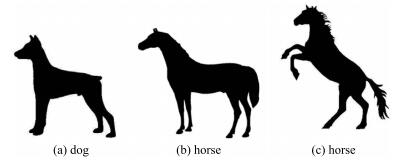
 下载:
下载:
